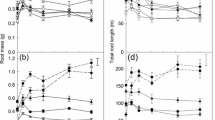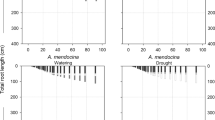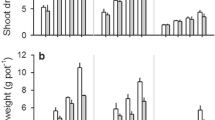Abstract
Perennial pasture species are important for sustainable pasture systems; yet some species display poor persistence on acid soils. This work investigated the effect of soil acidity on primary root length and root-hair and rhizosheath development of five perennial grass genotypes varying in acid-soil resistance. Plants were grown in three low-P acid soils that were limed (CaCO3) to modify soil pH (0.01 M CaCl2 extractable) from <4.3 to >5.0 and Al3+ concentrations from ≥ 16 to <4 mg kg−1 (0.01 M CaCl2 extractable). Root morphology of tall wheatgrass (Thinopyrum ponticum (Podp.) Z.-W. Liu & R.-C Wang), phalaris (Phalaris aquatica L.), cocksfoot (Dactylis glomerata L.) and weeping grass (Microlaena stipoides Labill. R. Br.) was assessed after 20–25 days growth. The root length of tall wheatgrass and phalaris cv Sirosa was sensitive to acidity, with lateral root length more sensitive to acidity than seminal root length. Lime increased the root-hair length and density of both acid-soil sensitive and resistant genotypes (cocksfoot and an acid-resistant line of phalaris) and root-hair length was positively correlated to an increase in rhizosheath size per unit root length. Restricted root length and poor root-soil contact of acid-soil sensitive genotypes may explain their low yield and relatively poor persistence on acid soils. The improvement to root-hair and rhizosheath development of genotypes that are acid-soil resistant in terms of root length demonstrates the benefit of using resistant genotypes in conjunction with liming to manage acid soils. Weeping grass was exceptional in its ability to maintain root length, root-hair and rhizosheath development in acid soil.




Similar content being viewed by others
References
Arsenault JL, Poulcur S, Messier C, Guay R (1995) WinRHIZOTM, a root-measuring system with a unique overlap correction method. HortScience 30:906
Bailey C, Scholes M (1997) Rhizosheath occurrence in South African grasses. S Afr J Bot 63:484–490
Bromfield SM, Cumming RW, David DJ, Williams CH (1983) The assessment of available manganese and aluminium status in acid soils under subterranean clover pastures of various ages. Aust J Exp Agric 23:192–200
Colwell JD (1963) The estimation of phosphorus fertiliser requirements of wheat in southern New South Wales by soil analysis. Aust J Exp Agric Anim Husb 3:190–197
Crawford SA, Wilkens S (1998) Effect of aluminium on root elongation in two Australian perennial grasses. Aust J Plant Physiol 25:165–171
Culvenor RA, Oram RN, Fazekas de St Groth C (1986) Variation in tolerance in Phalaris aquatica L. and a related species to aluminum in nutrient solution and soil. Aust J Agric Res 37:383–395
Culvenor RA, Wood JT, Avery AL, Dempsey W, McDonald SE, Ronnfeldt G, Veness PE (2004) Multi-site evaluation on acid soils of a Phalaris aquatica x P. arundinacea x P. aquatica backcross population bred for acid soil tolerance. Aust J Agric Res 55:681–692
Delhaize E, Taylor P, Hocking PJ, Simpson RJ, Ryan PR, Richardson AE (2009) Transgenic barley (Hordeum vulgare L.) expressing the wheat aluminium resistance gene (TaALMT1) shows enhanced phosphorus nutrition and grain production when grown on an acid soil. Plant Biotechnol J 7:391–400
Gahoonia TS, Care D, Nielsen NE (1997) Root hairs and phosphorus acquisition of wheat and barley cultivars. Plant Soil 191:181–188
Haling RE, Simpson RJ, Delhaize E, Hocking PJ, Richardson AE (2010) Effect of lime on root growth, morphology and the rhizosheath of cereal seedlings growing in an acid soil. Plant Soil 327:191–212
Helyar KR, Conyers MK (1994) Ranking commercial pasture cultivar sensitivity to acidity and allocating estimated response functions to the cultivars. Final report to the Wool Research and Development Corporation on Project DAN 50. NSW Agriculture, Wagga Wagga
Isbell RF (1996) The Australian soil classification. CSIRO Publishing, Melbourne
Kemp DR, Dowling PM (2000) Towards sustainable temperate perennial pastures. Aust J Exp Agric 40:125–132
Kochian LV (1995) Cellular mechanisms of aluminum toxicity and resistance in plants. Ann Rev Plant Physiol 46:237–260
Krizek DT, Foy CD (1988) Role of water-stress in differential aluminum tolerance of 2 barley cultivars grown in an acid soil. J Plant Nutr 11:351–367
Li GD, Helyar KR, Conyers MK, Cullis BR, Poile GJ, Knight PG (2004) Phalaris persistence under rotational grazing on a highly acidic soil on the south-west slopes of New South Wales. Aust J Exp Agric 44:771–778
Magcale-Macandog DB, Whalley RDB (1994) Factors affecting the distribution and abundance of Microlaena stipoides (Labill.) R. Br. on the northern tablelands of New South Wales. Range J 16:26–38
McCully ME (1999) Roots in soil: unearthing the complexities of roots and their rhizospheres. Ann Rev Plant Physiol 50:695–718
Moreno-Espindola IP, Rivera-Becerril F, de Jesus Ferrara-Guerrero M, De Leon-Gonzalez F (2007) Role of root-hairs and hyphae in adhesion of sand particles. Soil Biol Biochem 39:2520–2526
Munnich DJ, Simpson PC, Nicol HI (1991) A survey of native grasses in the Goulburn district and factors influencing their abundance. Range J 13:118–129
Rayment GE, Higginson FR (1992) Australian laboratory handbook of soils and water chemical methods. Inkata Press, Melbourne
Reeve IJ, Kaine G, Lees JW, Barclay E (2000) Producer perceptions of pasture decline and grazing management. Aust J Exp Agric 40:331–341
Reuter DJ, Robinson BJ (1997) Plant analysis: an interpretation manual. CSIRO Publishing, Melbourne
Ridley AM, Slattery WJ, Helyar KR, Cowling A (1990) Acidification under grazed annual and perennial grass based pastures. Aust J Exp Agric 30:539–544
Ridley AM, Windsor SM (1992) Persistence and tolerance to soil acidity of phalaris and cocksfoot in north-eastern Victoria. Aust J Exp Agric 32:1069–1075
Scott BJ, Conyers MK, Poile GJ, Cullis BR (1997) Subsurface acidity and liming affect yield of cereals. Aust J Agric Res 48:843–854
Scott BJ, Coombes NE (2006) Poor incorporation of lime limits grain yield response in wheat. Aust J Exp Agric 46:1481–1487
Scott BJ, Fisher JA, Cullis BR (2001) Aluminium tolerance and lime increase wheat yield on the acidic soils of central and southern New South Wales. Aust J Exp Agric 41:523–532
Shainberg I, Sumner ME, Miller WP, Farina MPW, Pavan MA, Fey MV (1989) Use of gypsum on soils: a review. Adv Soil Sci 9:1–111
Sumner ME (1993) Gypsum and acid soils: the world scene. Adv Agron 51:1–32
Tang C, Rengel Z, Abrecht D, Tennant D (2002) Aluminium-tolerant wheat uses more water and yields higher than aluminium-sensitive one on a sandy soil with subsurface acidity. Field Crops Res 78:93–103
von Uexkull HR, Mutert E (1995) Global extent, development and economic impact of acid soils. Plant Soil 171:1–15
Watt M, McCully ME, Canny MJ (1994) Formation and stabilization of rhizosheaths of Zea mays L. 1. Effect of soil-water content. Plant Physiol 106:179–186
Acknowledgements
This research was funded by a Hackett Postgraduate Research Scholarship awarded to REH (The University of Western Australia), Meat and Livestock Australia and CSIRO. Thanks are due to Adam Stefanski and Phillip Armstrong for technical assistance.
Author information
Authors and Affiliations
Corresponding author
Additional information
Responsible Editor: Tim Simon George.
Rights and permissions
About this article
Cite this article
Haling, R.E., Richardson, A.E., Culvenor, R.A. et al. Root morphology, root-hair development and rhizosheath formation on perennial grass seedlings is influenced by soil acidity. Plant Soil 335, 457–468 (2010). https://doi.org/10.1007/s11104-010-0433-z
Received:
Accepted:
Published:
Issue Date:
DOI: https://doi.org/10.1007/s11104-010-0433-z




